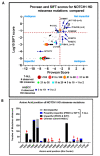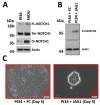NOTCH1 Signaling in Head and Neck Squamous Cell Carcinoma
- PMID: 33322834
- PMCID: PMC7764697
- DOI: 10.3390/cells9122677
NOTCH1 Signaling in Head and Neck Squamous Cell Carcinoma
Abstract
Biomarker-driven targeted therapies are lacking for head and neck squamous cell carcinoma (HNSCC), which is common and lethal. Efforts to develop such therapies are hindered by a genomic landscape dominated by the loss of tumor suppressor function, including NOTCH1 that is frequently mutated in HNSCC. Clearer understanding of NOTCH1 signaling in HNSCCs is crucial to clinically targeting this pathway. Structural characterization of NOTCH1 mutations in HNSCC demonstrates that most are predicted to cause loss of function, in agreement with NOTCH1's role as a tumor suppressor in this cancer. Experimental manipulation of NOTCH1 signaling in HNSCC cell lines harboring either mutant or wild-type NOTCH1 further supports a tumor suppressor function. Additionally, the loss of NOTCH1 signaling can drive HNSCC tumorigenesis and clinical aggressiveness. Our recent data suggest that NOTCH1 controls genes involved in early differentiation that could have different phenotypic consequences depending on the cancer's genetic background, including acquisition of pseudo-stem cell-like properties. The presence of NOTCH1 mutations may predict response to treatment with an immune checkpoint or phosphatidylinositol 3-kinase inhibitors. The latter is being tested in a clinical trial, and if validated, it may lead to the development of the first biomarker-driven targeted therapy for HNSCC.
Keywords: NOTCH1; head and neck squamous cell carcinoma; mutation; phosphatidylinositol 3-kinase; synthetic lethal; tumor suppressor.
Conflict of interest statement
The authors declare no conflict of interest.
Figures








Similar articles
-
PDK1 Mediates NOTCH1-Mutated Head and Neck Squamous Carcinoma Vulnerability to Therapeutic PI3K/mTOR Inhibition.Clin Cancer Res. 2019 Jun 1;25(11):3329-3340. doi: 10.1158/1078-0432.CCR-18-3276. Epub 2019 Feb 15. Clin Cancer Res. 2019. PMID: 30770351 Free PMC article.
-
Targeting HIF-1α/NOTCH1 pathway eliminates CD44+ cancer stem-like cell phenotypes, malignancy, and resistance to therapy in head and neck squamous cell carcinoma.Oncogene. 2022 Feb;41(9):1352-1363. doi: 10.1038/s41388-021-02166-w. Epub 2022 Jan 10. Oncogene. 2022. Retraction in: Oncogene. 2025 Mar;44(11):782. doi: 10.1038/s41388-025-03316-0. PMID: 35013621 Retracted.
-
HEY1 is expressed independent of NOTCH1 and is associated with poor prognosis in head and neck squamous cell carcinoma.Oral Oncol. 2018 Jul;82:168-175. doi: 10.1016/j.oraloncology.2018.05.017. Epub 2018 Jun 1. Oral Oncol. 2018. PMID: 29909892
-
The NOTCH Pathway in Head and Neck Squamous Cell Carcinoma.J Dent Res. 2018 Jun;97(6):645-653. doi: 10.1177/0022034518760297. Epub 2018 Feb 28. J Dent Res. 2018. PMID: 29489439 Free PMC article. Review.
-
Molecular pathways in head and neck cancer: EGFR, PI3K, and more.Am Soc Clin Oncol Educ Book. 2013:246-55. doi: 10.14694/EdBook_AM.2013.33.246. Am Soc Clin Oncol Educ Book. 2013. PMID: 23714515 Review.
Cited by
-
Sustained Aurora Kinase B Expression Confers Resistance to PI3K Inhibition in Head and Neck Squamous Cell Carcinoma.Cancer Res. 2022 Dec 2;82(23):4444-4456. doi: 10.1158/0008-5472.CAN-22-1175. Cancer Res. 2022. PMID: 36169922 Free PMC article.
-
Notch1 Phase Separation Coupled Percolation facilitates target gene expression and enhancer looping.bioRxiv [Preprint]. 2024 Aug 1:2023.03.17.533124. doi: 10.1101/2023.03.17.533124. bioRxiv. 2024. Update in: Sci Rep. 2024 Sep 19;14(1):21912. doi: 10.1038/s41598-024-71634-6. PMID: 39131356 Free PMC article. Updated. Preprint.
-
WBP5 Expression Influences Prognosis and Treatment Response in Head and Neck Squamous Cell Carcinoma.Cancers (Basel). 2025 Feb 8;17(4):587. doi: 10.3390/cancers17040587. Cancers (Basel). 2025. PMID: 40002180 Free PMC article.
-
Topical Bimiralisib Shows Meaningful Cutaneous Drug Levels in Healthy Volunteers and Mycosis Fungoides Patients but No Clinical Activity in a First-in-Human, Randomized Controlled Trial.Cancers (Basel). 2022 Mar 15;14(6):1510. doi: 10.3390/cancers14061510. Cancers (Basel). 2022. PMID: 35326659 Free PMC article.
-
Increased NOTCH1 expression is associated with low survival in moderate/ poor differentiated human oral squamous cell carcinoma patients.J Cancer. 2023 Sep 18;14(16):3023-3027. doi: 10.7150/jca.87128. eCollection 2023. J Cancer. 2023. PMID: 37859809 Free PMC article.
References
-
- Chow L.Q.M., Haddad R., Gupta S., Mahipal A., Mehra R., Tahara M., Berger R., Eder J.P., Burtness B., Lee S.H., et al. Antitumor Activity of Pembrolizumab in Biomarker-Unselected Patients with Recurrent and/or Metastatic Head and Neck Squamous Cell Carcinoma: Results from the Phase Ib KEYNOTE-012 Expansion Cohort. J. Clin. Oncol. 2016;34:3838–3845. doi: 10.1200/JCO.2016.68.1478. - DOI - PMC - PubMed
-
- Bauml J., Seiwert T.Y., Pfister D.G., Worden F., Liu S.V., Gilbert J., Saba N.F., Weiss J., Wirth L., Sukari A., et al. Pembrolizumab for Platinum- and Cetuximab-Refractory Head and Neck Cancer: Results from a Single-Arm, Phase II Study. J. Clin. Oncol. 2017;35:1542–1549. doi: 10.1200/JCO.2016.70.1524. - DOI - PMC - PubMed
-
- Harrington K.J., Ferris R.L., Blumenschein G., Jr., Colevas A.D., Fayette J., Licitra L., Kasper S., Even C., Vokes E.E., Worden F., et al. Nivolumab versus standard, single-agent therapy of investigator’s choice in recurrent or metastatic squamous cell carcinoma of the head and neck (CheckMate 141): Health-related quality-of-life results from a randomised, phase 3 trial. Lancet Oncol. 2017;18:1104–1115. doi: 10.1016/S1470-2045(17)30421-7. - DOI - PMC - PubMed
Publication types
MeSH terms
Substances
Grants and funding
LinkOut - more resources
Full Text Sources
Other Literature Sources
Medical

